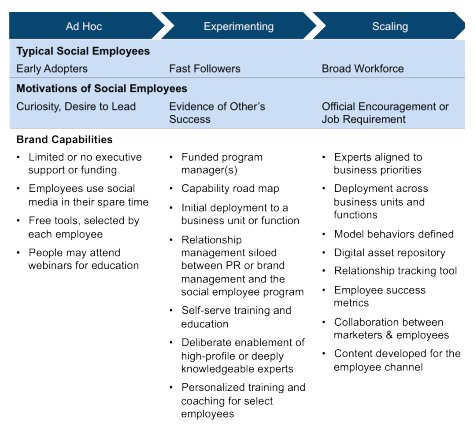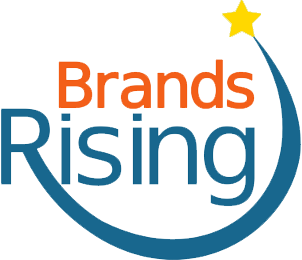When you begin to plan the services you will provide to employees that you enable in social media, you will need to align your plans with your organization’s maturity in social media as well as the maturity in social employee empowerment. In general, the level of support that a brand provides to employees usually follows three broad stages of evolution, shown below:

In the beginning, Early Adopters, sprinkled across the company, begin to use social media on their own. They receive limited support from the brand, and probably no funding. They use free tools in their spare time, and they might attend webinars or local free conferences (see meetup.com for opportunities) to connect with other people with similar interests in using social media for business. Individuals are experimenting, but the organization is not. We call this stage Ad Hoc.
In the second stage of development, experimentation moves from the individual level to the organizational level. At this stage, Fast Followers see the Early Adopters having some success, and they begin to follow. At this point, the organization gives someone accountability for enabling some set of employees in social media. They are officially spending money on it. There may be a road map for developing the capabilities needed for success, but the scope is usually limited to one business unit or functional team, such as marketing or customer service. Training is usually self-serve for most employees, via the employee portal or an internal collaboration platform. Select employees get a higher level of support, and maybe some personalized training or coaching.
In the third stage of evolution, which we call Scaling, the organization buys into the power of enabling employees in social media, and scales capabilities across the organization. Most of the workforce is encouraged and supported to engage in social media. In addition, experts are aligned to business priorities, and probably even partner with product marketers to support marketing programs and editorial calendars. Metrics for success are defined and regularly assessed for each employee who is a subject matter expert or thought leader. Employees participate because their Manager encourages it, and, in some cases, social media engagement is required for their job.
Finally, the organization develops content specifically for distribution through employees in social media. And they even measure the performance of that content. However, typical metrics such as engagement and reach won’t tell you what you need to know about your employee’s social advocacy success. To learn more about what to measure and how, head to “Chapter 3: You Will Measure New Things in New Ways,” of my book, The Most Powerful Brand on Earth.
